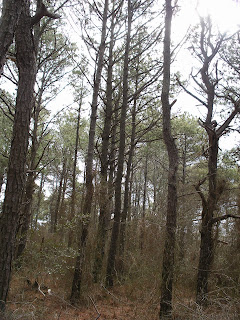
(Bor-ing)
Why do I weep for the forsythia? Because I love these harbingers of spring that brighten up the muddy March garden when it's struggling for breath after getting bodyslammed by winter. Unfortunately, my forsythia was planted in a terrible location: soil filled with lava rocks in deep shade. Consequently, it blooms anemically every spring, nowhere close to its full potential.

(It looks happy enough, but...)
Why not move it, you ask? Because those who planted it put it directly over the electrical, gas, and cable lines! Digging up this shrub means risking life, limb, and destroying cable TV for the entire neighborhood, which would undoubtedly result in an angry mob swarming my house with torches and pitchforks.
But enough about anemic forsythias and angry mobs; I'm looking to the future! The north border that I reclaimed from the lava rocks is crying out for a shrub to anchor its corner (or at least that's what I think it's saying). It has a tree at one end (which I believe is a box elder) and a number of perennials waiting to burst to life next year: 'City of Haarlem' hyacinths and 'El Cid' tulips in early spring, nectaroscordums and 'Ruffled Velvet' irises in late spring and purple coneflowers in summer that will hopefully be joined by yellow coneflowers (Ratbida pinnata), provided that the seed I have is viable and the seedlings survive. There are also tufts of little bluestem (Schizachyrium scoparium), which are blogalong passalongs from Mr. McGregor's Daughter.

(One shrub, please! A specimen, not a traveling hedge-former.)
We'll see how that all pans out next year, but it will be a big improvement over the previous state of the border! As you've likely figured out, purple and yellow is the predominant color scheme. As you've also noticed, that's a lot of flowers and herbaceous material and not much (or really any) woody material. So I thought for a bit of symmetry and structure I should add a shrub to the currently empty corner. It would provide fall color and winter interest as well as a contrast to all the perennials. So I started searching...
This site is challenging, to put it mildly. It receives barely any sun because it's on the north side of the house and at the confluence of our fence with a neighbor's tree just above it. So shade tolerance is a must. The soil is my terrible clay along with a good dose of remnant lava rocks mixed in. On the bright side, there was a peony growing here when I moved in. I transplanted it and its brethren from this north bed to the front yard where they've exploded in the full sun, so I am confident that something can grow here. But what?
My first thought was goat's beard (Aruncus dioicus), which is actually an herbaceous perennial and would kind of negate the whole reasoning behind the shrub. But hear me out! Goat's beard grows up to 6' tall, thus is the size of a shrub, and it's a shade-loving native. It blooms with shaggy white panicles in early summer, hence the name. The problem would be lack of fall color and winter interest, which are two of the main reasons I want a shrub. It's a possibility, a fall-back, but not a lock.
Next I thought about a sweetspire (Itea virginica). It shares many attributes with the goat's beard: white panicles, shade tolerant, manageable size, North American native. Even better than the goat's beard, this one has gorgeous fall color and will provide more structure as a truly woody plant. Chicagoland Grows developed a particularly fiery specimen named 'Scarlet Beauty' that is proven hardy to the Chicago region. Perhaps a frontrunner?

(Lots of hibernating herbaceous stuff, could use some contrast.)
Then I started to think a little bigger. What about a pagoda dogwood (Cornus alternifolia)? It has a wonderful shape and would certainly add the structure I'm looking for. And I could just prune it to keep it at the correct size, right? I wouldn't neglect to prune a shrub, would I? That 'Golden Shadows' would look fabulous with the purple and yellow color scheme, that's for sure! But would this site be too shady for it? Does it maybe hopefully get more sun than I'm giving it credit for?
At this point I was thrilled with the possibilities and confused about what plant was truly right for this site. Yes, it's mostly shady thanks to the fence, but that also means it's a protected site, probably the most sheltered on our whole property. So then I began to think some more, and many other ideas swirled through my head above and beyond just shrubs. I'll share them with you in another upcoming post, as my quest for the shade border shrub continues...
Muse Day is graciously hosted by Carolyn Gail at Sweet Home and Garden Chicago. Please visit to see more thoughts on this first day of the month!
































